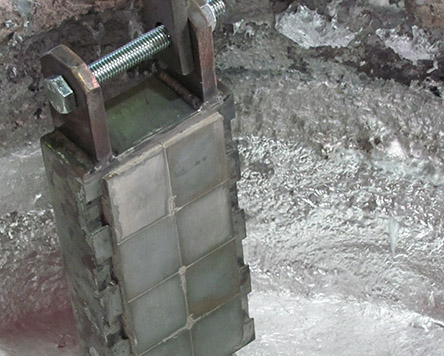Quick introduction: Foundry
Modern foundry plants are characterized by higher energy efficiency, improved control mechanisms and reliable plant components. A weak point of previous systems, however, are the so-called dross separators. These are used to remove slag residues and oxides from the surface of the metal melt and to roughly clean the melting tank after emptying. Scratch plates are made of steel and are corrosively removed from the molten casting alloy on the one hand and mechanically subjected to heavy loads during the cleaning process on the other. In particular, the corrosive load during processing of the casting alloy leads to rapid wear of the plates, so that they have to be replaced at short intervals.
In order to increase service life and reduce maintenance costs, the Fraunhofer IKTS in cooperation with Rackwitz Industrieanlagen GmbH has developed ceramic protective plates for cladding the metal surface of the dross separators. Due to its outstanding mechanical and corrosive properties, silicon nitride was selected as a ceramic material and specifically modified and evaluated for use in aluminum melts. The new material has a very high fracture toughness and strength up to over 800°C. The new material is also suitable for use in aluminium melts. Investigations into the interactions between aluminium and ceramics showed that there is no damaging influence on the ceramic surface. In addition, the molten aluminium hardly adheres to the ceramic after solidification, or adheres only slightly, and can be easily removed.
In addition, the Fraunhofer IKTS has developed a joining concept to attach the ceramic protective plates to the dross separator. The joint is designed in such a way that thermally induced expansion differences do not lead to potentially damaging tensile stresses being introduced into the ceramics. The adhesive connection between the ceramic plates connects the plates with each other and thus leads to a stable fixation on the separator. It also prevents the molten aluminium from penetrating behind the plates. Due to the weak bonding of the adhesive to the metal, it is possible to remove individual plates manually by means of hammer blows and allows replacement in the event of local damage.
